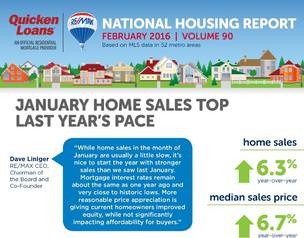RE/MAX researches 53 major metropolitan markets and analyzes the data to get a pulse on the US housing market. Here are some highlights from the February 2016 report.
February 2016 National Housing Report
January home sales were 6.3% higher than those one year ago, about the same year-over-year increase seen in December. At the same time, anticipated seasonal trends resulted in 31.7% fewer sales in January than December. Since January 2009, the average drop in sales from December was 27.6%. Over the last 12 months, the average year-over-year increase in sales has been 5.6% and only two months, November and October, did not rise above year-ago sales. The Median price of all homes sold in January was $200,714, or 6.7% higher than January 2015. The inventory of homes for sale remains very tight in many metros across the country, at a level that is 14.7% lower than one year ago. At the rate of home sales in January, the national Months Supply of inventory was 4.6, down from 5.2 one year ago.
“While home sales in the month of January are usually a little slow, it’s nice to start the year with stronger sales than we saw last January.  Mortgage interest rates remain about the same as one year ago and very close to historic lows. More reasonable price appreciation is giving current homeowners improved equity, while not significantly impacting affordability for buyers,” said Dave Liniger, RE/MAX CEO, Chairman of the Board and Co-Founder.
Mortgage interest rates remain about the same as one year ago and very close to historic lows. More reasonable price appreciation is giving current homeowners improved equity, while not significantly impacting affordability for buyers,” said Dave Liniger, RE/MAX CEO, Chairman of the Board and Co-Founder.
“Home valuations continue to rise as the economy strengthens and buyers find home-ownership often cheaper than renting. The number of potential homebuyers outpaced sellers in some markets. On the other hand, some areas are more balanced, producing slower growth or even a slight decline in some months. It is important to remember that tepid growth is not necessarily a cause for concern, but rather a sign of a healthy and sustainable market,” added Bob Walters, Quicken Loans, Chief Economist.
Closed Transactions – Year-over-year change
In the 52 metro areas surveyed in January, the average number of home sales were 6.3% higher than one year ago, but were 31.7% lower than the previous month. January home sales are typically less than those in December and since January 2009, the average decrease has been 27.6%. January home sales appeared to be especially strong in the northeast, in places like Boston, Philadelphia, Trenton, Manchester and Burlington. In December, 38 of the 52 metro areas surveyed reported higher sales on a year-over-year basis with 13 experiencing double-digit increases: Trenton, NJ +31.3%, Burlington, VT +30.9%, Manchester, NH +27.0%, Boston, MA +22.1%, Philadelphia, PA +16.8%, and Minneapolis, MN +16.2%.
Median Sales Price
The Median Sales Price for all homes sold in the month of January was $200,714, down 2.3% from December. On a year-over-year basis, the Median Sales Price has now risen for 48 consecutive months, but January’s increase of 6.7% is less than the average of 7.6% for each month in 2015. A low inventory supply continues to pressure prices, although price increases have been moderating over the last few months. Among the 52 metro areas surveyed in January, 49 reported higher prices than last year, with 15 rising by double-digit percentages, including Tampa, FL +19.4%, Nashville, TN +16.1%, Trenton, NJ +15.2%, Orlando, FL +14.6%, Des Moines, IA +13.9% and Denver, CO +12.9%.
Days on Market – Average of 52 metro areas
The average Days on Market for all homes sold in January was 71, up 4 days from the average in December, but 9 days lower than the average in January 2015. January becomes the 34th consecutive month with a Days on Market average of 80 or less. In the two markets with the lowest inventory supply, Denver and San Francisco, Days on Market was 40 and 36 respectively. Only four metro areas had a Days on Market average of 100 or greater; Burlington, VT 103, Des Moines, IA 105, Chicago, IL 107 and Augusta, ME with a 165-day average. Days on Market is the number of days between when a home is first listed in an MLS and a sales contract is signed.
Months Supply of Inventory – Average of 52 metro areas
The number of homes for sale in January was 5.0% lower than in December and 14.7% lower than in January 2015. The average year-over-year loss of inventory for each month in 2015 was 12.2%. Based on the rate of home sales in January, the Months Supply of Inventory of 4.6 was slightly lower than December’s 4.9, and was lower than the 5.2 average in January last year. A 6.0 Months Supply indicates a market balanced equally between buyers and sellers. Augusta, ME continued with the highest January supply at 12.7. Five metros had a supply of 2 months or less, including Denver, CO 1.2, San Francisco 1.4, Seattle 1.5, Portland, OR 1.7 and Dallas-Ft. Worth, TX 2.0.
The February 2016 report uses the statistic from the month of January. Remember that Nick & Cindy Davis are available by calling 813-300-7116 or simply click here and we will be in touch with you shortly.
To download the full report click the download now button below.